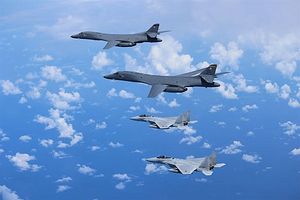Two U.S. Air Force B-1B Lancer conventional strategic bombers joined Japanese Air Self-Defense Force (ASDF) fighters on Saturday for aerial drills in the East China Sea.
According to U.S. Pacific Command, the U.S. Air Force bombers deployed from Ellsworth Air Force Base, South Dakota, to participate in the exercises.
After the conclusion of the drills, one bomber returned to Andersen Air Force Base, on Guam, near where North Korea had threatened to target intermediate-range ballistic missiles in August.
The second bomber returned to Misawa Air Base in Japan “to be a static display for the Misawa Air Festival,” according to U.S. Pacific Command.
The exercises came on North Korea’s 69th founding day, when Pyongyang had been expected to potentially carry out a new ballistic missile launch.
“The purpose of this bilateral training is to foster increased interoperability between Japan and the U.S.,” U.S. Pacific Air Forces spokeswoman Lt. Col. Lori Hodge noted.
“Following the operation, one B-1B flew to Misawa Air Base to be a static display for the Misawa Air Festival, while the other B-1B returned to Andersen Air Force Base,” she added.
U.S. B-1B bombers, which are perceived by North Korea to be strategic nuclear-capable assets even though they are only capable of conventional missions, are regularly involved in signalling activities on and near the Korean Peninsula.
North Korean state media often alludes to U.S. B-1B flights as a source of tension. In August, North Korea had suggested, before the U.S.-South Korea Ulchi-Freedom Guardian bilateral wargames, that if the U.S. stopped B-1B flights, it would also reduce the rate of its provocations.
Saturday’s exercise is the second show-of-force in East Asia involving U.S. bombers since North Korea’s sixth nuclear test, in which it claimed to have tested a thermonuclear bomb.
Immediately after the nuclear test, the United States dispatched F-35 Joint Strike Fighters and B-1B bombers, along with Japanese ASDF and Republic of Korea Air Force (ROKAF) F-15 fighters for a major show of force.
U.S. officials assess that North Korea detonated a device with at least 140 kilotons of TNT equivalent explosive power; the U.S. intelligence assessment is ongoing, The Diplomat understands and so far, U.S. officials have not found conclusive evidence to suggest that North Korea’s claim that it tested a staged thermonuclear weapon was exaggerated.

































